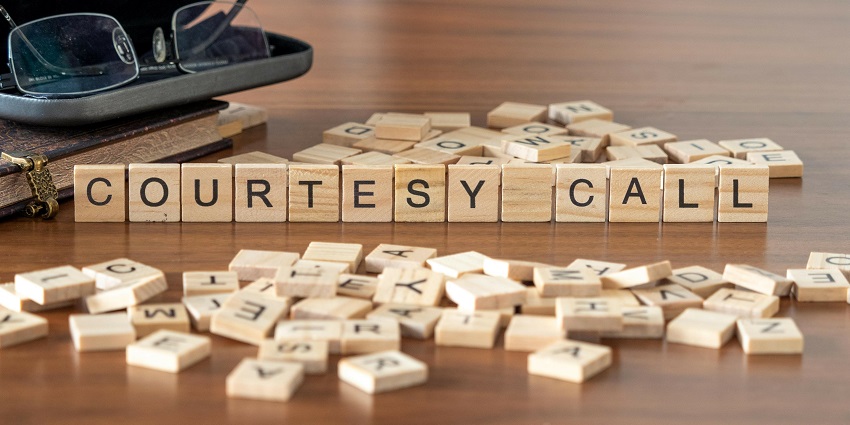For most customer service operations, the last two years have proven a tumultuous. Some witnessed layoffs/furloughs and high agent turnover.
In contrast, others struggled to adapt to new remote working realities. According to Enghouse Interactive, 52 percent of British customers said that the quality of service has worsened during the pandemic due to long wait times (72 percent), ineffective automated menus (56 percent), and lack of first contact resolution (21 percent).
While not all of this is preventable, companies can get ahead of a decline in service through the tried-and-tested practice of courtesy calls. This demonstrates to customers that the company’s service strategy is not just reactive, and that the company does not take customer relationships for granted.
A Definition of Courtesy Calling
Courtesy calling is the practice of making phone calls to a customer and thanking them for their business. In doing so, agents may ask if they are satisfied with the company’s service, solve potential problems, and make cross-sell suggestions without any direct request from the customer.
More often used in the B2B space, courtesy calls aim to strengthen high-value relationships and enhance the value of the customer’s experience.
However, some operations will define “courtesy calls” as follow ups to abandon calls. So, be wary of potential misunderstandings.
What to Include In a Courtesy Call
A courtesy calling script will typically have the following components:
An Agent Introduction
Consider this example: “Hello, this is (title) from (name of the business) here and in (name of the city, state). This is only a courtesy call. I’m phoning existing customers to check if we’re fulfilling their expectations; do you have a moment?”
If yes, the agent can proceed to the next component. If not, they can thank the customer for their time, provide the business’ contact number, and offer help with any of their future needs.
Statement of Purpose and Value-Add to the Customer
The call center agent outlines the purpose for contacting the customer while also giving the consumer a reason to answer the phone. Here are several examples:
- I’m phoning to check whether we fulfill your requirements (business client).
- Are there any difficulties that I can assist you with?
- Have you been introduced to our (Name) Store Manager?
If yes, the agent can proceed to the next component. If not, it is best to inquire whether there is anything more the company can do for them; if not, share the phone number.
Agents should always thank the consumer for their attention and time and wish them a pleasant hour of the day (i.e., day/evening).
Yet, when stating the purpose, avoid mentioning the possibility of a cross-sell. Sneak this in at the end of the call as – otherwise – it will appear pushy.
Objection Handling
The customer may use this time to file a complaint or seek assistance. If the agent is unsure how to solve the problem at the time, they should inform the customer that they will conduct some background or case-based research and ring them back.
It is best to use a CRM to take notes on the nature of the problem and inform the client that the matter will be transferred to the most relevant team or person if required.
Answers to FAQs
Be proactive. Instead of waiting for customers to come to an issue pass on some advice now to help them overcome without further assistance down the line.
Here, operations can also test customer understanding of the product/service to remove any ambiguity and pinpoint potential mis-sell practices.
A Cross-Sell
Making an additional sale must not appear the main purpose of the courtesy call. Yet, if the agent makes a smart connection between what the customer has purchased and a similar product, a sales plug – towards the backend of the call – may earn extra, customer-friendly revenues.
Alternatively, if businesses do not wish to take this risk, consider asking customers for an opt-in to receiving marketing emails. Asking them directly is much more likely to deliver results than classic tick-box approaches.
Closure
To end the courtesy call, agents can make a statement like: “Thank you for your kind attention and time; it was a pleasure talking with you.” They may also invite the customer to continue the conversation – e.g., “Please contact me at any time of your preference; my number is xxxx-xxx-xxxx.”
The call should always be brief and succinct, without taking too much of the customer’s time.
Why Is Courtesy Calling Important to CX?
Focusing on practical, helpful communication may help small businesses gain credibility, respect, and trust. Courtesy calling is an excellent approach to remind clients of forthcoming meetings, check on the delivery of a return or exchange, or confirm receipt of payment.
Such a strategy is sometimes valuable in the following situations:
- A customer phoned a helpdesk; has the problem been addressed, and is the customer satisfied?
- Is the new model or product the customer purchased delivering on expectation?
- How is the replacement agent performing when the person formerly assigned to a client failed to meet expectations?
However, agents must execute the courtesy call properly. Customers dislike unwanted sales calls, particularly if they already have an ongoing relationship with the company. However, a polite call is permissible when carried out intelligently.
Improve your courtesy call strategy further by considering these 11 Acknowledgment, Empathy, and Reassurance Statements for Customer Service







